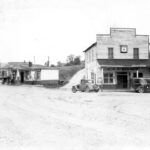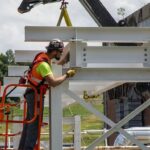
An image showing the footprint of the former mile-long, U-shaped K-25 Building at the former K-25 site in west Oak Ridge, now known as East Tennessee Technology Park or Heritage Center. Built during World War II to enrich uranium, the K-25 Building has been demolished but its “footprint” has been preserved. This image shows the footprint at center, the K-25 History Center on the second floor of the city-owned fire station, front right, and the Equipment Building and Viewing Tower at front left. (Graphic by David Brown/U.S. Department of Energy)
A bill approved by the Senate Appropriations Committee on Thursday recommends $8 million for K-25 historic preservation work.
If approved, the funding would help preserve the historic contributions that the K-25 Site made to the Manhattan Project, a top-secret federal program to build the world’s first atomic bombs during World War II.
The historic preservation work is required under a 2012 agreement that allowed the complete demolition of the K-25 Building, which was once the world’s largest building under one roof.
The 2012 agreement allowed workers to demolish the North Tower at the mile-long, U-shaped K-25 Building in west Oak Ridge. Historic preservationists had lobbied for years to save the North Tower.
In exchange for the complete demolition of K-25, the agreement, announced in August 2012, called for a replica equipment building, a viewing tower, and a history center at a city-owned fire station. It also included an online virtual museum and a $500,000 grant to buy and stabilize the historic Alexander Inn in central Oak Ridge, which has since been converted into an assisted living center.
Although the projects depend upon funding, the goal is to finish the work, including the equipment building and viewing tower, by 2019. Officials have previously said that implementation of the initiatives included in the preservation plan agreed to in 2012 could take five to seven years to carry out.
Federal officials have recently said that construction could start later this year or early next year on the K-25 History Center on the second floor of the city-owned fire station. That fire station, Fire Station Number 4, is at the former K-25 Site, which is now known as East Tennessee Technology Park or Heritage Center.
During an April 12 community budget workshop, Jay Mullis, acting manager of the Oak Ridge Office of Environmental Management, said the design and construction of the History Center will cost about $6 million, and at least another $6 million will be required to finish the History Center and start the Equipment Building. At least another $8 million to $9 million will be required to finish the Equipment Building and Viewing Tower, Mullis said. That’s roughly $20 million total.
The $8 million in funding recommended last week is included in the Fiscal Year 2018 Energy and Water Development Appropriations Bill that was approved by the U.S. Senate Appropriations Committee in a 30-1 vote on Thursday. It’s part of $266 million recommended for the U.S. Department of Energy for non-defense environmental cleanup. (See page 84 of this report on the Senate bill.)
The bill had previously been approved in a voice vote by the Senate Energy and Water Development Appropriations Subcommittee, which is chaired by U.S. Senator Lamar Alexander, a Tennessee Republican.
The appropriations bill cites the K-25 Site’s connections to the relatively new Manhattan Project National Historical Park, which was established in November 2015.
“The Manhattan Project National Historical Park tells an important story in our nation’s history: the development and production of the technology and materials necessary to create the world’s first atomic bomb,” the Senate bill says.
The unique, three-site Manhattan Project National Historical Park has locations in Oak Ridge, Tennessee; Hanford, Washington; and Los Alamos, New Mexico. It is administered and operated by the National Park Service in conjunction with the U.S. Department of Energy, which owns many of the Manhattan Project-era facilities.
Specific plans for integrating K-25 into the park haven’t been announced yet.
The three history-related facilities at K-25 will have three missions. The History Center will tell the story of the workers. The Equipment Building will focus on the technology. And the Viewing Tower will show visitors the size of the site. All three facilities will be on the south side of the former K-25 Building. (Learn more about these history-related facilities in this story from May.)
The U.S. House of Representatives’ Energy and Water Development Appropriations bill doesn’t appear to specifically include funding for the K-25 historic preservation agreement. Instead, the House bill, approved by the House Appropriations Committee on July 12, asks for a project update. (See pages 92-93 of this report on the House bill.)
“Since fiscal year 2015, Congress has provided support for a memorandum of agreement for historic preservation of the K–25 gaseous diffusion uranium enrichment facility in Oak Ridge, Tennessee,” a report on the House bill said. “Not later than 30 days after the enactment of this act, the department shall provide to the committees on appropriations of both houses of Congress a report that describes the department’s plan, total cost, and proposed schedule for meeting the commitments made in its agreement.”
Asked for an update Friday, Mullis  said “everything is still on track.”

An image showing what the K-25 History Center could look like on the second floor of the city-owned fire station at East Tennessee Technology Park. (Graphic by David Brown/U.S. Department of Energy)
The K-25 Building once covered 44 acres, and it enriched uranium for four decades before it was shut down in the mid-1980s. The K-25 site is slowly being converted into a large industrial park.
There had once been a plan to keep the North Tower at the K-25 Building, but concerns about safety, the deteriorated condition of the building, and the cost apparently made that impractical.
The August 2012 agreement wrapped up a decade of discussion over how to commemorate the historic contributions of K-25. Those who signed the agreement included the U.S. Department of Energy, the State Office of Historic Preservation, the federal Advisory Council on Historic Preservation, the City of Oak Ridge, and the East Tennessee Preservation Alliance.
K-25 used a process called gaseous diffusion to enrich uranium for atomic weapons and, later, for commercial nuclear power plants. Officials and contractors have said that K-25 helped win the Cold War.
The K-25 site was one of three large sites built by the federal government in Oak Ridge during World War II to help make the world’s first atomic weapons as part of the Manhattan Project. The other two sites were X-10, which is now known as Oak Ridge National Laboratory, and Y-12, now the Y-12 National Security Complex.
See previous stories here:
- Final signature clears way for demolition of K-25 North Tower
- Community celebrates K-25 historic preservation agreement
- Construction could start this year on K-25 History Center
More information will be added as it becomes available.

An image showing the Equipment Building and Viewing Tower at the former K-25 site, now known as East Tennessee Technology Park or Heritage Center. The Equipment Building and Viewing Tower are part of an effort to preserve the history of the site. K-25 was built during World War II to enrich uranium for the top-secret bomb-building Manhattan Project, and it was once the world’s largest building under one roof. (Graphic by David Brown/U.S. Department of Energy)

An image showing the K-25 History Center on the second floor of the city-owned fire station, right, at East Tennessee Technology Park, with the Equipment Building and Viewing Tower at left. (Graphic by David Brown/U.S. Department of Energy)

Now demolished, the former mile-long, U-shaped K-25 Building, pictured above, was once used to enrich uranium for atomic weapons and commercial nuclear power plants. Located in west Oak Ridge, the site could become part of a Manhattan Project National Historical Park. There is a separate effort to preserve the site’s history; that work could be incorporated into the new park. (File photo courtesy of U.S. Department of Energy)
Do you appreciate this story or our work in general? If so, please consider a monthly subscription to Oak Ridge Today. See our Subscribe page here. Thank you for reading Oak Ridge Today.
Copyright 2017 Oak Ridge Today. All rights reserved. This material may not be published, broadcast, rewritten, or redistributed.








Leave a Reply